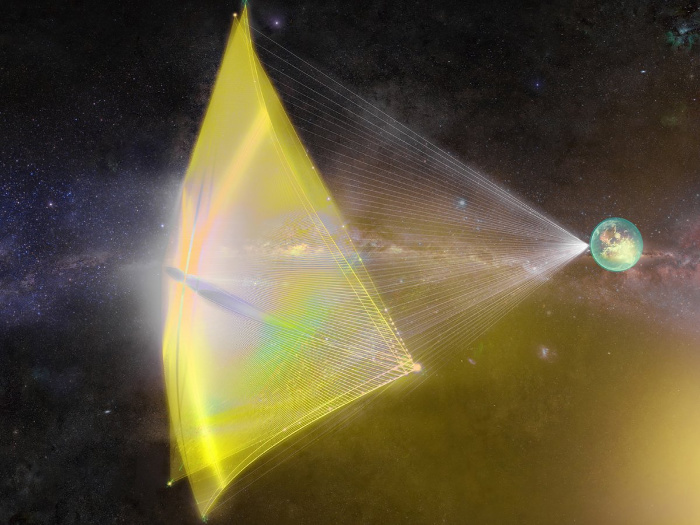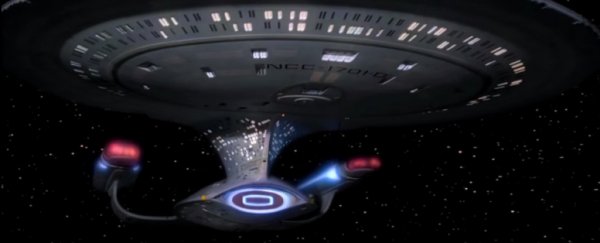In the sci-fi universe of "Star Trek", spaceships with warp drives can zoom past the normally impenetrable limit of light speed, or about 186,282 miles per second (299,792 kilometers per second) in a vacuum.
This trouncing of theoretical physics makes reaching alien-rich planets across the galaxy seem like just a convenient TV-commercial-break-length trip away.
But a new animation by the planetary and space scientist James O'Donoghue, who used to work at NASA and is now employed by JAXA (Japan's national space agency), grounds the warp drives of those fictional spaceships in reality.
He says the work gives him "a sense of despair" about travelling through space, even at superluminal speeds.
O'Donoghue previously animated the speed of light within the solar system, and the results were depressing. After receiving widespread attention for those animations, he began wondering what going faster might look like in reality.
So O'Donoghue took the Federation starship USS Enterprise, commanded by Captain Jean-Luc Picard (played by Patrick Stewart) in Star Trek: The Next Generation, and sent it flying from the sun to Pluto at varying warp-speed velocities.

The animated video above, which O'Donoghue posted on Twitter on Monday, is almost as deflating as the scientist's first set of popular animations.
"I have genuinely felt a sense of despair at the distances involved in our solar system and beyond," O'Donoghue told Business Insider, adding: "It's been one of my aims to make everyone else feel as bad as me."
Incidentally, a follow-on series titled Star Trek: Picard is scheduled to premiere on CBS All Access on January 23 and on Amazon Prime the following day, according to CNN.
What the new 'Star Trek' warp-speed animation shows – and why it's depressing
There's no set-in-stone scale of "warp-factor" speeds in the "Star Trek" universe. Over the more than 50 years of productions, different series and episodes and movies throw out conflicting numbers.
However, Rick Sternbach and Michael Okuda – two technical advisers to The Next Generation series – published a technical manual in 1991 that includes some solid figures, and it's those numbers (vis-a-vis a Wikipedia page) that O'Donoghue said he leaned on for his animation.
That scale suggests a warp factor of 1 is light speed (shown below between Earth and the moon) and the typical upper limit warp of 9.99 is more than 2,140 times light speed.

O'Donoghue chose to depict the Enterprise flying away from the sun and across the solar system toward a finish line at Pluto.
The spaceship starts out at warp 1 and eventually accelerates to warp 9.9, or about 2,083 times light speed.
- Warp 1, or light speed, makes the Enterprise look like it's at a standstill over the sun. At this light-speed rate, the ship would take 5 hours and 28 minutes just to reach Pluto, which is about 3.67 billion miles (5.9 billion kilometers) away from the sun. Meanwhile, Proxima Centauri – the nearest star to our own – is a dismal four years and three months away.
- Warp 5 is about 213 times faster, making a sun-Pluto journey just 1 minute and 30 seconds long. Proxima Centauri is still a weeklong voyage.
- Warp 9.9 makes Pluto less that a 10-second trip away, and Proxima Centauri an 18-hour cruise.
This last rate of travel is thousands of times faster than the physics of our Universe may ever permit.
However, travelling at a warp factor of 9.9 from one end of the Milky Way galaxy – a body of hundreds of billions of stars that may stretch 150,000 to 200,000 light-years wide, according to a recent study – to the other could take 96 years. That's almost a decade longer than an average human life span today.
Even considering the fastest "transwarp" (or "beyond warp") speed achieved by the Enterprise, which is about 8,323 times light speed, according to Star Trek: The Next Generation – Technical Manual, a transgalactic voyage would take 24 years. A transwarp voyage to Andromeda, which is the nearest galaxy to ours at about 2.5 million light-years away, would last about 300 years.
A quarter of a century is a gruelling amount of time that no holodeck, artificially intelligent companions, and extremely well-stocked spaceship bar may stack up against, let alone three centuries.
"It is difficult to feel sorry for them, however," O'Donoghue said of the people in the "Star Trek" Universe, since "we ourselves haven't achieved even a 10th of 1 percent of the speed of light in our fastest-ever spacecraft."
Humanity moves really, really slowly through space
The fastest any human-built object has ever gone relative to the sun is about 119 miles per second (192 kilometers per second), or 430,000 mph (692,000 kilometers per hour). NASA's Parker Solar Probe briefly achieves this speed when it careens around the sun, and flying to Pluto from the sun at that rate would take nearly a year.
Engineers with the Breakthrough Starshot project are working toward achieving partial light-speed travel with tiny "nanocraft".
 (Breakthrough Foundation)
(Breakthrough Foundation)
The idea is to rapidly accelerate them by shooting reflective light sails with powerful laser beams, ultimately flying them past nearby stars like Proxima Centauri (a red dwarf that just might host habitable planets).
Yet even at a planned cruise velocity of 20% of light speed, it could take more than 21 years for the probes to fly past and photograph the nearby star system. On top of that, it'd take another 4.24 years for their radio signals (travelling at light-speed) carrying image data to reach antennas on Earth.
If we really want to feel lonely, though, O'Donoghue thinks we need look no farther than science fiction itself.
"I think it adds a layer of isolation and grittiness to know that even our nearest star takes dozens of hours at a rarely used warp 9.9 to get to," O'Donoghue said.
"Perhaps this gives viewers a better sense of the magnitude of space and the frontier nature of the Federation ships and crew."
This article was originally published by Business Insider.
More from Business Insider:
